Since March 2020, European Democracy Consulting has been working on an assessment of the implementation of transparency provisions under Article 32 of Regulation 1141/2014 on European political parties. This work has led to several reports and to an inquiry by the European Ombudsman. Today, we conclude this process with recommendations for the reform of Regulation 1141/2014. This report can be found here in PDF format.
#0B5CBF;">Summary of recommendations |
#0B5CBF;">Recommendations for the APPF from EDC’s complaint to the Ombudsman
|
#0B5CBF;">Recommendations for the European Commission and Parliament for the review of Regulation 1141/2014
|
Table of Contents
Introduction
On 26 March 2020, European Democracy Consulting shared with the Authority for European Political Parties and European Political Foundations (APPF) a report highlighting perceived failures by the APPF to abide by its transparency requirements.
In the absence of corrective action by the APPF in the following three months, European Democracy Consulting used this report to file a complaint with the European Ombudsman on 26 June.
On 28 July, the Ombudsman decided to open an inquiry and invited the APPF to provide its comments, which it did on 5 October; European Democracy Consulting responded to these comments on 15 October.
Finally, on 25 January 2021, the European Ombudsman rendered her decision.
The first section of this assessment summarises European Democracy Consulting’s complaint and the main issues at hand. The second section responds to the points addressed by the Ombudsman’s decision. The third and last section lists our recommendations for the APPF and for the European Commission and Parliament with a view to improving Regulation 1141/2014.
As we have done from the beginning of this initiative, we wish to recall the constructive nature of our complaint, which takes good note of the limited size and funding of the APPF — a point emphasised by the APPF’s Director in his reply.
Our goal is to ensure that European citizens are provided with the adequate level of information and transparency over their European political parties; for this, we call for pro-active action by the APPF, for a review of the transparency provisions and requirements on the APPF under Regulation 1141/2014, and for an increase of the APPF’s human and financial resources.1
Part I: Summary of EDC’s complaint
The first part of this section recalls the legal obligations of the APPF arising from Article 32 of Regulation 1141/2014 on transparency. The second part sums up the current online availability of this information, on the websites of the APPF and of the European Parliament. The third part reviews broader issues relating to effective transparency.
1. Review of transparency obligations
Pursuant to Articles 6, 7 and 32, the European Parliament is required to “make public, under the authority of its Authorising Officer or under that of the Authority, on a website created for that purpose”2 a series of information. In layman’s terms, this information includes:
- the names and statutes of registered European political parties and foundations;
- the applications that have not been approved and the grounds for rejection;
- the documents submitted as part of applications for registration, whether the application has been approved or not;
- an annual report with amounts paid to each European political party and foundation;
- the annual financial statements and external audit reports of European political parties;
- the final reports on the implementation of the work programmes or actions of European political foundations;
- the names of donors and the value of donations for all donations reported by European political parties and foundations, for donations above €1,500 (if written consent was given, for donations above €1,500 and under €3,000);
- the number and sum of donations under €1,500 from natural persons and of donations above €1,500 and below €3,000 for which consent to publication was not given (bundled as “minor donations”);
- the contributions from legal entities members of European parties and foundations and the identity of the member parties or organisations which made those contributions;
- the details of and reasons for final decisions regarding sanctions taken by the Authority and the European Parliament;
- a description of the technical support provided to European parties;
- the evaluation report of the European Parliament on the application of this Regulation (starting in 2021); and
- an updated list of MEPs who are members of a European political party.
Additionally, the European Parliament is required to “make public the list of legal persons who are members of a European political party […] as well as the total number of individual members”.3
2. Current availability of required information on European parties
We note that, since the drafting of our initial report, information has been added on its website by the APPF; the updated table below reflects this.
| APPF | EP | |
| the names and statutes of registered European political parties and foundations; | ✓ | ✗ |
| the applications that have not been approved and the grounds for rejection; | ✓ | ✗ |
| the documents submitted as part of applications for registration, whether the application has been approved or not; | ✓ | ✗ |
| an annual report with amounts paid to each European political party and foundation; | ✗ | ✓ |
| the annual financial statements and external audit reports of European political parties; | ✗ | ✓ (see below) |
| the final reports on the implementation of the work programmes or actions of European political foundations; | ✗ | ✗ |
| the names of donors and the value of donations for all donations reported by European political parties and foundations, for donations above €1,500 (if written consent was given, for donations above €1,500 and under €3,000); | ~ (see below) | ✗ |
| the number and sum of donations under €1,500 from natural persons and of donations above €1,500 and below €3,000 for which consent to publication was not given (bundled as “minor donations”); | ~ (see below) | ✗ |
| the contributions from legal entities members of European parties and foundations and the identity of the member parties or organisations which made those contributions; | ~ (see below) | ✗ |
| the details of and reasons for final decisions regarding sanctions taken by the Authority and the European Parliament; | ~ (see below) | ✗ |
| a description of the technical support provided to European parties; | ✗ | ✓ (until 2019) |
| the evaluation report of the European Parliament on the application of this Regulation (starting in 2021); and | N/A | N/A |
| an updated list of MEPs who are members of a European political party. | ~ (see below) | ✗ |
As a general comment, we see that the required information is, at best, displayed on different websites and not on a single website as prescribed by Regulation 1141/2014.4
Donations and contributions. As of February 2021, the website of the APPF lists, for parties and foundations:
- For 2020:
- donations above €12,000;
- For 2019:
- donations above €12,000;
- donations below €12,000 received under six months of EP elections;
- donations below €1,500 and between €1,500 and €3,000 for which donors did not content to disclose their identity (“minor donations”) received under six months of EP elections;
- For 2018:
- contributions from national parties and political formations without their individual amounts (only total amount);
- donations above €3,000 and between €500 and €3,000 for which donors contented to disclose their identity; and
- donations below €500 and between €500 and €3,000 for which donors did not content to disclose their identity (“minor donations”).
According to Regulation 1141/2014, European parties and foundations have six months, following the end of their financial year, to provide the APPF with their annual financial statements, an external audit report on the annual financial statements, and the list of donors and contributors and their corresponding donations or contributions.5 However, donations received within six months of a European election must be reported on a weekly basis, and accepted donations above €12,000 must be immediately reported.
For the financial year 2020, it is therefore understandable that no further information be provided by the APPF.
For the financial year 2019, all information on donations was supposedly provided by European parties and foundations by the end of June 2020 at the latest. However, by February 2021, only information on donations above €12,000 or within six months of elections is provided. At least seven months after their reporting, the list of donations provided by the ten European parties — virtually a mere copy-paste to a single file — has still not been published by the APPF.
For 2018, all information is now provided. However, the PDF files of donations for European parties and foundations are dated 26 and 25 May 2020. Since this information was provided to the APPF before the end of June 2019, this means that it took almost an entire year for the APPF to copy-paste the information provided by European parties and foundations. While this actually increases transparency, we note that several amounts below €1,500 are listed, contrary to provisions under Article 32.
Regrettably, the information is only provided in PDF format, and not in machine-readable formats (CSV, XML, JSON, XLS, XLSX, ODF, etc.).
Finally, and although we recognise that the APPF is under no legal obligation to do so, the APPF has not taken any step to provide financial information on previous years. This information, which is available on the European Parliament’s website, would go a long way into providing a context to understand recent figures.
Sanctions. No information is provided on sanctions, making it unclear to citizens whether or not sanctions have ever been imposed or are simply not reported.
List of MEPs. There is no single list of MEPs, but each European party separately reports on its own MEPs using its own reporting format.
To this day, a reporting error made following the 2019 elections and notified in early November 2020 — whereby an MEP was registered by two European parties without her knowledge — has still not been corrected. The MEP has readily confirmed being a member of only one of those two European parties. Since this error has a direct impact on European parties’ amount of public funding,6 it is essential that it be corrected at the earliest opportunity. This error would not have been possible if a single list of MEPs had been used by the APPF.
3. Broader issues of transparency
Principles of transparency and good administration
The complaint went a step further than the bullet points listed under Article 32(1) and argued that the APPF’s transparency obligations were to be understood in the context of a general obligation requiring all EU entities to ensure effective transparency, and not merely the publication or re-publication of documents, as part of good administration measures. References to these obligations abound in EU documents.
The Charter of Fundamental Rights of the European Union, in its Article 41 on the Right to good administration, states that this right includes “the obligation of the administration to give reasons for its decisions.”7 In the specific context of the funding of European parties, this should lead the European Parliament and the APPF to provide contextual information on the sums distributed to European parties (including the process of the calculation and the number and names of MEPs taken into account for each party).8
This issue has also been addressed by the European Parliament and the Council in Regulation (EC) No 1049/2001 regarding public access to European Parliament, Council and Commission documents. The Regulation makes it clear, in its preamble, that “in order to ensure the full application of this Regulation to all activities of the Union, all agencies established by the institutions should apply the principles laid down in this Regulation.”9
Article 15 of the Regulation, on Administrative practice in the institutions, states that “institutions shall develop good administrative practices in order to facilitate the exercise of the right of access guaranteed by this Regulation” (emphasis added) and that “institutions shall establish an interinstitutional committee to examine best practice, address possible conflicts and discuss future developments on public access to documents.”10
The article makes clear that the notion of “right of access to documents”, recognised by the Charter of Fundamental Rights of the European Union in its Article 42, cannot be separated, in practice, from the issue of “ease of access” and, therefore, information available in an obscure fashion cannot be considered truly available to citizens.
The European Parliament is even clearer in its consideration of this issue, including via its resolution of 28 April 2016 on public access to documents (Rule 116(7)) for the years 2014-2015.
In preamble, the Parliament recalls that “full transparency underpins citizens’ trust in EU institutions, contributes to developing an understanding of the rights deriving from the legal system of the Union and an awareness and knowledge of the EU decision-making process, including the correct implementation of administrative and legislative procedures.” It continues by referencing the Charter of Fundamental Rights and Regulation 1049/2001 mentioned above, and indicates the aim “of ensuring that this right can be exercised as easily as possible, and of promoting good administrative practices regarding access to documents by ensuring democratic scrutiny of the activities of the institutions and ensuring that they comply with the rules enshrined in the Treaties” (emphasis added).
The resolution states clearly that European institutions “have to ensure compliance with the principles of full transparency, sharing and of informing citizens accurately and in good time” (para. 2, emphasis added) and that “citizens must have the right to know about, and scrutinise […] the way in which public money is apportioned and spent, and the ensuing outcomes” (para. 7). Specifically on the issue of ease of use, the Parliament “urges the EU institutions, bodies, offices and agencies to develop further a more proactive approach on transparency by proactively disclosing as many of their documents as possible, in the most simple, user-friendly and accessible way” and “considers, in particular, that the accessibility of information should be improved on by means of easy-to-use interfaces and search systems” (para. 9, emphasis added).
And, indeed, the online display of information means little if said information is not easily accessible to citizens. The European Parliament was again mindful of this in Article 18(2a) of Regulation 1141/2014 (added in a 2018 amendment) when it required European parties to include, in their application for public funding, evidence that their member parties displayed European parties’ logo and political programme “in a clearly visible and user-friendly manner”.
Bearing in mind this context illustrating the way EU entities are required to carry out their transparency obligations, the information provided by the APPF and, to a lesser degree, by the European Parliament, cannot currently be considered to be “clearly visible” in a “user-friendly manner” or to meet the necessary standards of ease of use.
Information on European parties on the website of the European Parliament
Located in a section of a page relating to “contracts and grants”, listed under “other websites”, the information hosted on the website of the European Parliament simply cannot be considered “clearly visible” to the public.
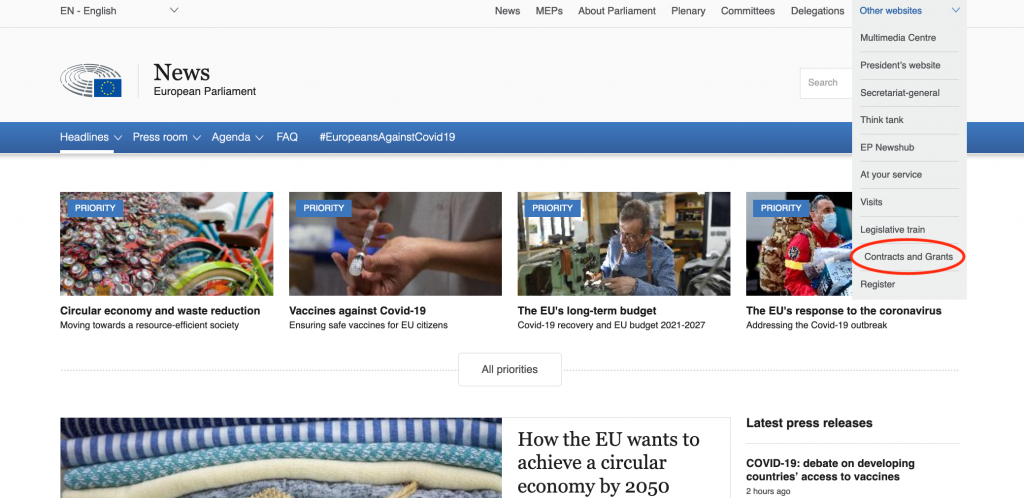
As for its accessibility, part of the information published by the European Parliament on European parties and foundations is user-friendly, with documents being provided in DOC or XLS format. However, financial information about the public funding granted to European parties and foundations is in PDF version only, and not in a machine-readable formats. Likewise, financial statements and audit reports not only are provided in PDF format, but are often scanned versions of printed documents, making any computer-assisted analysis nearly impossible.
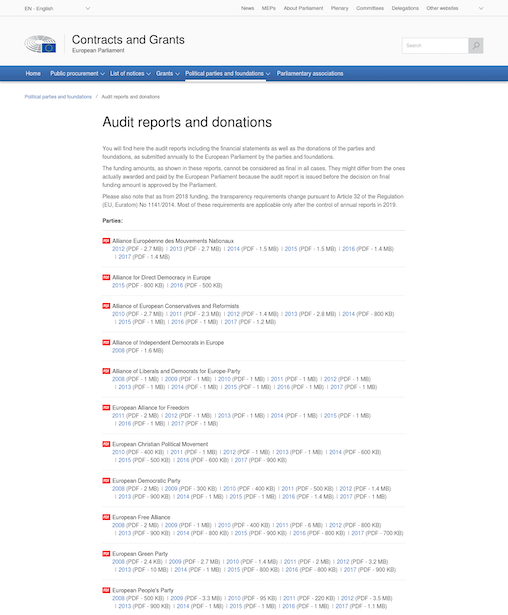
Information on European parties on the website of the APPF
Conversely, information located on the website of the APPF is clearly visible, being on a website that is dedicated to this topic. However, most of the information that the APPF does publish on its website is only published as lists of PDF files. While this is understandable for documents such as statutes, the use of PDFs, especially from scanned documents, for lists of MEPs, lists of members, or electoral records makes any analysis of this information impossible. It therefore falls far short of the criterion of user-friendliness.
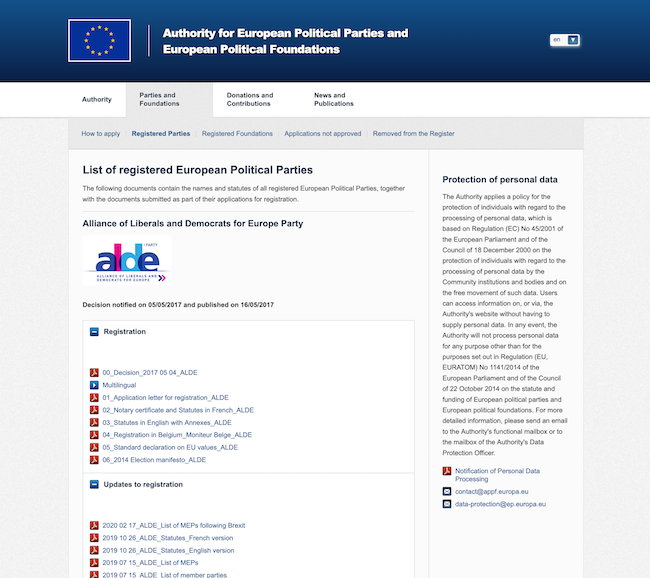
In the case of the electoral results of European parties’ members, this information, provided by European parties, is in one or several PDF files, and often amounts to little more than screen captures from the websites of national electoral commissions, bundling all results together in two-to-three-hundred-page-long documents.
From the point of view of the public, the press, or social scientists, none of the information contained in these documents is clearly visible, usable or user-friendly and cannot be considered to meet the spirit of the Regulation’s requirements on transparency.
Part II: Decision of the Ombudsman
The points above formed the basis of European Democracy Consulting’s complaint to the European Ombudsman, lodged on 26 June 2020. On 25 January 2021, the Ombudsman rendered her decision. Its main points are summarised below; for each, European Democracy Consulting provides its response.
1. Dedicated website for European parties and foundations
Decision (summary)
In her decision, the Ombudsman underlines that, “given the role they play in the EU’s democratic system, information concerning European political parties and foundations should be made available in a consistent, comparable and timely manner.”
The Ombudsman “considers that the APPF’s commitment to include links to the relevant sections of the Parliament’s website will address this issue, by making it easier for visitors to the APPF’s website to access this information.”
She adds that it is “more reliable to link to the website of the body responsible for publishing the information in question (in this case, the Parliament). As such, the APPF can be reassured that it is linking to the latest available information from the responsible entity.”
Our response
First of all, European Democracy Consulting welcomes the Ombudsman’s call for information on European political parties to be provided “in a consistent, comparable and timely manner.” We have shown in our case that this is not the case, with required some information missing and some provided almost a full year after being provided by European parties to the APPF.
Secondly, while it may be understandable to use links to avoid the provision of outdated information where said information is continuously or often updated, this argument becomes much less persuasive when the information in question consists only of past reports that will not be updated (such as for audits before 2018) or is only updated once a year (for instance, the amount of funding provided to European parties). In these cases, the provision to a single link to the European Parliament’s website is a poor alternative to simply having these files listed on the APPF’s website and to updating the figures once a year. There is little doubt that the APPF is kept informed by the relevant parliamentary services when funding amounts are approved.
Above all, this decision underlines the mutual incompatibility of three requirements of Regulation 1141/2014, namely 1) entrusting two different bodies with reporting obligations, 2) requesting information to be provided on a single website, and 3) requiring information to be provided in a user-friendly manner. One or two of these requirements may be reached at the same time, but not all three.
Therefore, while the Ombudsman’s decision respects the APPF’s and Parliament’s dual reporting obligations under Regulation 1141/2014 and may marginally improve citizens’ access to information, it falls short of ensuring that information is on a single website and, above all, that it is truly user-friendly. A revision of Regulation 1141/2014 must ensure that a single body is entrusted with the monitoring of and provision of information on European political parties.
2. Complete and accessible information
Decision (summary)
As in the previous point, the Ombudsman recognises, for purposes of public scrutiny, that “the APPF should make available as much information about them as possible, in particular financial information.” This includes “all information it is required to under the applicable legislation”, “as a bare minimum.”
Accordingly, the Ombudsman calls on the APPF to “publish on in its website any information that is supposed to be published (according to Regulation 1141/2014) but is not currently.” For instance, “a consolidated list of all MEPs by party affiliation, as is legally required, is missing.”
Furthermore, the Ombudsman “welcomes the APPF’s commitment to provide a link to the relevant information on the Parliament’s website” and “suggests that [the APPF] included a short explanation of why it publishes information only from 2018 onwards.”
She also “welcomes the APPF’s commitment to creating a page on its website concerning sanctions” and “to introduce a template to obtain information in a clear and harmonised manner from European political parties.”
Our response
European Democracy Consulting welcomes the Ombudsman call, not only for the “bare minimum”, but for “as much information about [European parties] as possible” to be published by the APPF. We are convinced that it is in the public interest to receive more information on European parties, in particular contextual information for the information legally required, and that the APPF is the best-placed actor to provide this information to citizens.
Unfortunately, the APPF has made it clear, both in its emails to European Democracy Consulting and in its comments to the Ombudsman, that it believes it already publishes all required information under Regulation 1141/2014. Beyond the minimal commitments it has made (a link to the Parliament’s website, an empty page for sanctions, and the use of reporting templates), it has shown no willingness to substantially increase the information it publishes with a view to better informing citizens. A simple call to abide by existing obligations without specific requirements is unlikely to change this stance.
A revision of Regulation 1141/2014 should expand on the information required of the APPF and entrust it with a clear mission of public information.
3. Format
Decision (summary)
The Ombudsman notes that Regulation 1141/2014 “does not indicate in what format the information should be made available.” Nonetheless, given Regulation 1141/2014’s objective to enhance visibility and transparency on European parties, the Ombudsman insists that “information should be provided to the public in the most user-friendly and accessible format to make it easily extractable, comparable and consistent.”
Accordingly, the Ombudsman calls on the APPF to “make available on its website all information that it is required to publish under Regulation 1141/2014 (such as financial information about European parties and foundations) in an open data format.” The APPF should also “improve its website, with a view to making it more user-friendly and accessible, including by providing a search function.”
Our response
European Democracy Consulting warmly welcomes the Ombudsman’s call for information, in particular financial information, to be provided in an open data format as well as for the APPF’s website to be improved to make it more user-friendly.
We indeed note that the APPF has committed, both in its emails to European Democracy Consulting and in its comments to the Ombudsman, to work on improving its website in the future, including by taking into account the points raised by European Democracy Consulting.
However, this encouraging statement can only be assessed against action taken. In this regard, we sadly note that the APPF has committed in early October to adding a section on sanctions — an empty page indicating that no sanctions have ever been imposed — and that, four months later, said section is still not added to the APPF’s website.
A revision of Regulation 1141/2014 should make clear that information on European parties ought to be published in an open format, and not merely republished as it was provided by European parties to the APPF.
The APPF has also regularly pointed to its limited staff and resources as a reason for not providing more information. While this argument may, to a certain extent, be valid, we must ensure that it does not constitute a get-out-of-jail-free card. In the short term, the European Parliament should increase the resources of the APPF; in the longer term, the APPF’s budget must be extracted from the European Parliament’s budget.
Part III: Recommendations
In light of the above, this last section recalls European Democracy Consulting’s initial recommendations to the APPF (updated as necessary) and expands upon them with recommendations for the European Commission and Parliament with a view to improving Regulation 1141/2014.
1. Initial recommendations to the APPF
Based on the shortcomings identified, European Democracy Consulting made the following recommendations, both from the point of view of Article 32(1)’s explicit requirements and for citizens’ experience in accessing this information.
- Consolidate all information on a single website. For all intents and purposes, the “single website” referred to in Article 32(1) is clearly that of the APPF. The APPF should therefore ensure that the entirety of the information listed is available in a single location. Of course, redundancy is not an issue, and the European Parliament is welcome to continue displaying information on European parties and foundations it deems useful on its own website.
- Ensure the information provided is complete and matches the Regulation’s requirements. As we have seen, the APPF does provide information related to donations; however, the information is incomplete and not in line with transparency provisions.
- Ensure the absence of information is not confused with missing information. As we have seen, the APPF’s website has no information on sanctions applied to European parties or foundations, making it unclear whether sanctions have never been applied or whether information on sanctions is simply missing. The APPF has committed to acting on this point but has yet to follow through.
- Ensure the information provided is up-to-date and consistently provided. Financial statements and audit reports are only provided until 2018. It also took close to a year for the APPF to provide information on donations made in 2018, and information is very incomplete for 2019 — at least seven months after it was provided to the APPF.
- Ensure the information provided is clear and understandable. It is essential, for the sake of clarity, to disaggregate financial data. For instance, when indicating the funding made available to European parties and foundations, it is essential to indicate how much (in euros, not only percentage) stems from the lump sum amount given equally to all parties, and how much comes from the MEP-based allocation (including which MEPs are counted for which party).
- Ensure the information provided is in machine-readable formats. While some documents are understandably in PDF format, data must be available in machine-readable formats (CSV, XML, JSON, XLS, XLSX, ODF, etc.). This availability is essential in order to allow interested parties — most prominently the press and social scientists — to carry out their work of analysis and vigilance, and hold political stakeholders accountable.
- Go beyond the Regulation’s requirements. The Regulation contains a list of essential information that must be publicly available to citizens. However, for the proper understanding of European parties and of their role in the European political system, more information is needed and ought to be provided on the APPF’s website. The European Parliament’s website can be a source of inspiration, as it strives to display electoral data — including the vote share and seats of its parliamentary groups — at the EU level and broken down by Member State in an interactive and clearly understandable manner. The APPF could provide similar information and more, from the point of view of European parties, including the vote count, vote share, and elected MEPs of their member parties. We are happy to support this process by providing our own data of electoral results for the 2019 European election; all this data is sourced, can be downloaded in Excel format, and reused for the APPF’s own website.
2. New recommendations for the improvement of Regulation 1141/2014
The decision of the European Ombudsman highlights an important shortcoming: while it can confirm that the APPF is failing to abide by some of its requirements (see §35 and §38), it is mostly limited to the text of Regulation 1141/2014 and can only “suggest” that the APPF “make available as much information about them as possible”, “make available on its website all information […] in an open data format”, and “improve its website”.
For this reason, the upcoming review of Regulation 1141/2014, carried out by the European Commission and European Parliament, is a unique opportunity to improve the text of the Regulation in light of the shortcomings identified.
European Democracy Consulting therefore calls on the European Commission and Parliament to account for the following recommendation in their review of Regulation 1141/2014.
1. Expand the information to be made public under the Regulation
While the European Ombudsman calls on the APPF to “make available as much information about [European parties] as possible”, and despite similar calls in the Charter of Fundamental Rights and Regulation 1049/2001, the current situation highlights the APPF’s and European Parliament’s reluctance to make public more information than is strictly required. It is therefore necessary to expand the information that is legally required to be made public.
For instance, information on donations and contributions provided by the APPF for the financial year 2018 lists: the total value of minor donations and the number of donations this figure combines, the identity of donors and amount of donations for donations above €3,000 (and donations between €500 and €3,000 where consent was given), and the total value of contributions by member parties and the names of these parties.
However, the APPF does not indicate the value of each contribution provided by each member party. This is despite Article 32(1)(f) indicating that the following should be published: “the contributions referred to in Article 20(7) and (8) and reported by European political parties and European political foundations in accordance with Article 20(2), including the identity of the member parties or organisations which made those contributions.”

Article 20(7) and (8) merely authorise contributions by their members to European parties and foundations. Article 20(2) is a requirement on European parties and foundations to provide information to the APPF.
In practice, the APPF has chosen to understand Article 32(1)(f) as requiring the publication of, on the one hand, the total value of contributions by member parties and, on the other, the list of contributors — instead of the list of contributions and, for each, the name of the contributor.
The provision of Article 32(1)(f) should therefore be reviewed to ensure that the value of each contribution is listed separately and tied to the member party that provided it.
We also note that the APPF has listed the names of individual donors, separately from the “minor donations” category, for donations as low as €500, contrary to the provisions of Article 32(1)(e).11 We propose to review Article 32(1)(e) to lower or even remove the minimum value of donations that can be reported alongside the name of their donor, provided consent is given.
Furthermore, clear information must be provided on the calculation to obtain the distribution of funding attributed to each European party, including the amount of the lump sum in euros, the amount provided to European parties for each MEP in euros, and the list of MEPs who are considered as members of each European party for the purpose of funding.
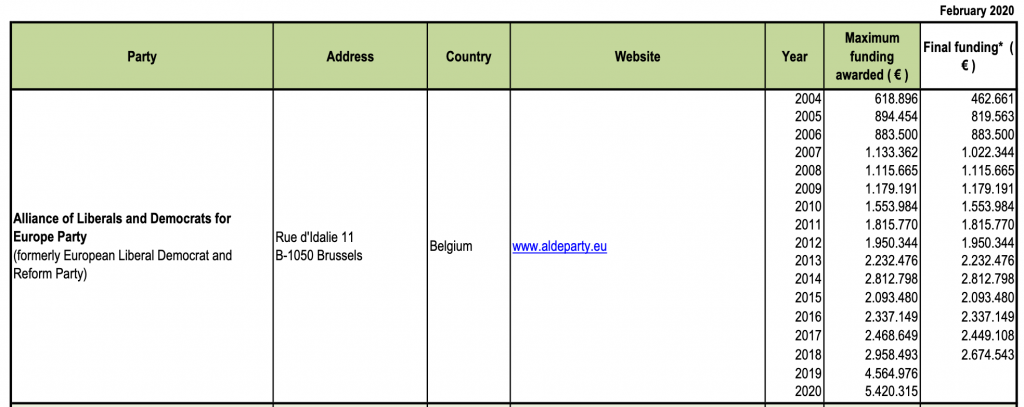
Finally, the APPF has decided to publish, on its website, the official results of European elections provided by European parties. This is a most welcome development, but is not listed in Regulation 1141/2014.12 For clarity’s sake, Article 32 should clearly request the publication of electoral results and the modalities for this reporting. This data should include, at a minimum, information at the European and national levels for each European party on the total number of votes, share of the vote, number of MEPs, share of MEPs, voter turnout, gender balance, and the link between national and European parties. Similar information is already provided by the European Parliament from the perspective of parliamentary groups.
2. Include time limits for the publication of information
Following the end of the financial year, European political parties are given six months to submit to the APPF their annual financial statements and accompanying notes, an external audit report on the annual financial statements, and the list of donors and contributors and their corresponding donations or contributions.13
However, no time constraints are placed on the APPF and we have seen that, in practice, the APPF has taken almost an entire year to copy-paste information on donations provided by European parties — therefore information that did not require analysis of any kind but merely had to be published as reported.
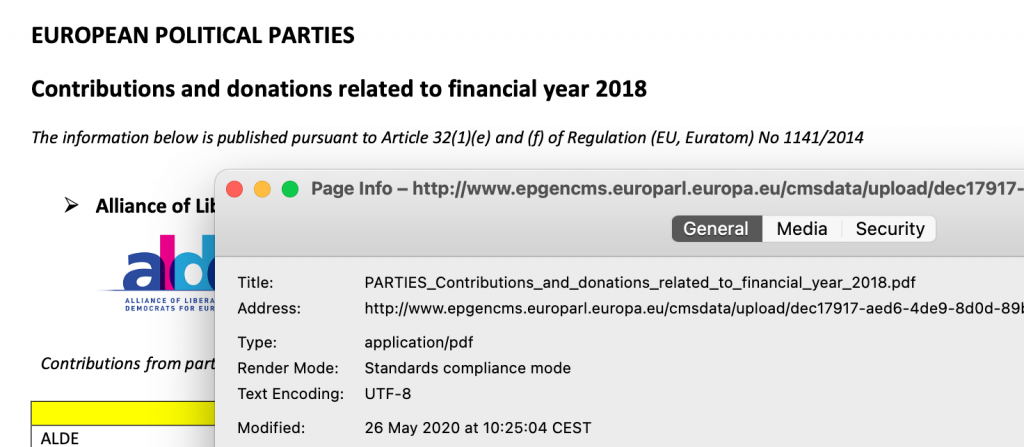
At the very least, Article 32(1) and (2) should include the goal to make public the listed information “at the earliest opportunity” or “in a timely manner”.
Beyond this broad goal, Article 32 should be reviewed to ascribe a deadline for the publication of information or data that does not require a specific intervention by the APPF (data that is to be published as it is reported to the APPF). For instance, the APPF could be given one month from the deadline of submissions to make this data public.
In order to ease this process, the APPF should provide a clear, open-format reporting template to European parties, which would make the data extraction process harmonised and automated.
Furthermore, Article 23 could be reviewed to differentiate the reporting deadlines given to European parties based on the type of information. For instance, while a duration of six months is welcome for annual financial statements and an external audit report, the list of donors and the value of donations can be transmitted to the APPF much more quickly. And, should parties provide information on donations within three or four months, the APPF would have already published it by the time the financial reports and external audit are provided, ensuring the publication of information on donations is not further delayed by the extra workload.
3. Require information to be published in open and machine-readable formats
As we have explained, and as confirmed by Regulation 1049/2001 and the EP Resolution of 28 April 2016, the mere online publication of files does not ensure the true transparency of information.14 The Ombudsman supports this view in her call for the APPF to provide its information in an open format.15
The European Parliament has applied this principle to electoral results, for which it provides open and machine-readable data sheets going back to 1979 (JSON, XML and CSV, and images in JPG and PNG).
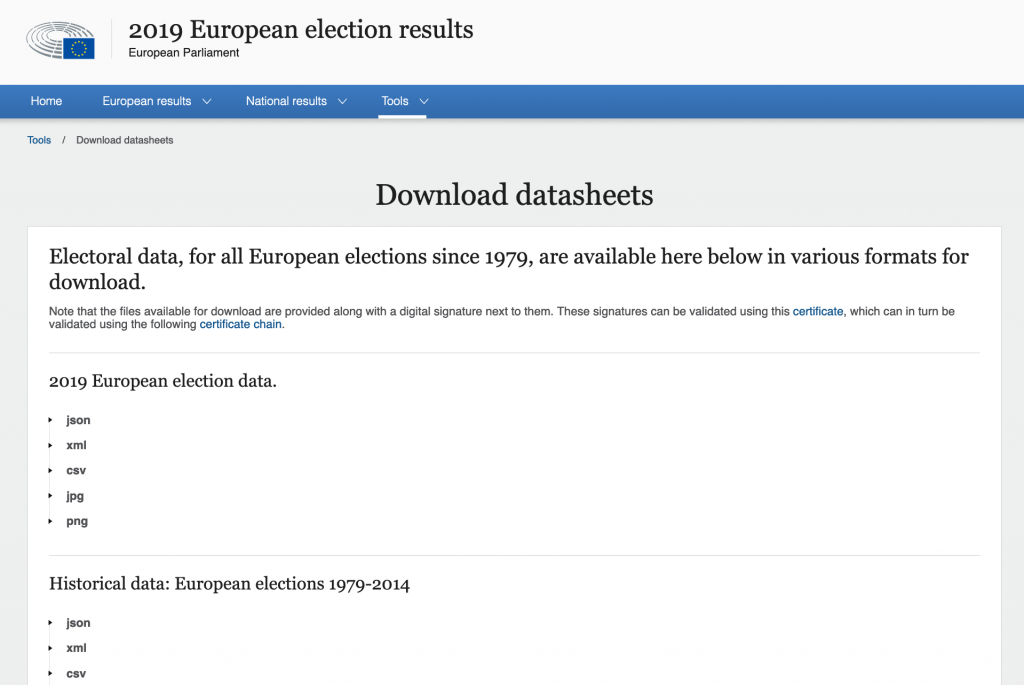
Since Directive 2019/1024 of 20 June 2019 on open data and the re-use of public sector information does not apply to EU institutions, Article 32 should be reviewed to include the specific requirement to provide data — including, but not limited to, all donations and contributions (both public and private) and electoral results — in open and machine-readable formats (CSV, XML, JSON, XLS, XLSX, ODF, etc.).
The use of these formats for reporting templates by European parties will go a long way to harmonise the information received by the APPF, and automate and simplify its analysis and re-publication.
4. Require the graphic display of information
While the provision of data in open and machine-readable formats is essential for the analysis of this data by members of academia or the press, it achieves little for the direct understanding of the vast majority of citizens visiting the APPF’s or Parliament’s websites. Citizens accessing a website need the most important information presented graphically in a clear and intelligible way with the relevant contextual information.
The European Parliament has clearly understood this and already provides useful visual information on its website with regards to electoral results for each of its parliamentary groups, but not for European parties.
Currently, the APPF and the European Parliament do not provide a single graph regarding European parties, thereby severely limiting the intelligibility of the information they provide to citizens accessing their websites.
Article 32 should therefore be reviewed to include the specific requirement that relevant information — including, but not limited to, donations and contributions (both public and private), public funding received by European parties, and electoral results16 — be displayed graphically in a user-friendly manner.
5. Entrust the APPF with a clear mission of public information
The above recommendations — to expand the information to be made public, to provide deadline for the provision of information, to provide this information in open and machine-readable formats, and to require its graphic display — are all important provisions.
However, there is only so much specific information that the Regulation can list, and the APPF should instead internalise a general requirement to provide information on European parties. In addition, the APPF should not feel limited to provide only current information, but instead list and display historical information on European parties that may provide a useful context for citizens seeking to understand their European parties.
Leaving the APPF with the freedom to provide this information, with no particular mention of it in Regulation 1141/2014, has led to a situation where absolutely no contextual or historical information is published by the APPF. On the contrary, the APPF has argued to European Democracy Consulting and to the Ombudsman that it does not seek to go beyond its strict interpretation of its transparency requirements under Regulation 1141/2014.
In order to remedy this situation and provide the necessary impetus for the APPF to provide contextual and historical information on European parties, Article 6 should be reviewed to include, for instance in paragraphs (1) or (2), an explicit mission of public information on European parties. This provision would legally empower and require the APPF to provide supplementary information useful to citizens for the understanding of their European parties. Best practices can be drawn from information published by similar bodies at the national level.
6. Carry out a yearly review of the implementation of transparency requirements
Given the low level of information received by European citizens on European parties, it is essential to make a supplementary effort in this area, and Regulation 1141/2014 must take this into account.
Currently, the Regulation only provides, in Article 38, that the “European Parliament shall [every five years] report on the application of this Regulation.”
While a five-year review of the entire Regulation itself is sufficient to analyse the consequences of the framework created by the Regulation, a more frequent appraisal should be conducted for the specific purpose of assessing compliance with transparency requirements. This would naturally be extended to other activities of public information, should this become part of the APPF’s mandate, as proposed in Recommendation 5 above.
Article 38 should be reviewed to include a yearly review of the implementation of the Regulation’s transparency requirements. This short assessment by the European Parliament would help ensure that sufficient and timely information is provided to citizens, without the need to wait until the end of the next five-year cycle.
7. Entrust a single body with the monitoring of European political parties
Most of the above recommendations target Article 32 on transparency. As we have seen, Regulation 1141/2014 contains three mutually incompatible requirements, namely 1) entrusting two different bodies with reporting obligations, 2) requesting information to be provided on a single website, and 3) requiring information to be provided in a user-friendly manner. One or two of these requirements may be reached, but, as the current situation shows, not all three.
The European Parliament seemingly tried to ensure that information would be easily accessible to citizens despite the dual involvement of the APPF and of the European Parliament by requiring information to be provided “on a single website.”
In practice, the APPF argues that, since the roles are shared between the APPF and the European Parliament, the APPF’s website can only be relied upon to provide information on items for which the APPF is responsible. As a result, the requirement to have all information on a single website is upheld neither by the APPF, nor by the European Parliament, and this important element for transparency is discarded.
A quick fix would be to amend Article 32 to specify which website should be the single receptacle of all this information. It would be logical that this should be the website of the APPF, given its dedication to the topic of European parties, while the website of the European Parliament deals mostly with parliamentary issues.
A much more sensible avenue for reform would be to follow best practices at the national level where, in the presence of a dedicated body in charge of political parties, this body is wholly entrusted with all monitoring and transparency functions concerning these parties. By contrast, Regulation 1141/2014 splits these roles between the APPF (“established for the purpose of registering, controlling and imposing sanctions”) and the European Parliament, via an “Authorising Officer”, for all issues related to funding (administration of calls for contributions, distribution of funds, financial reporting, control, sanctions, recovery, etc.).
Entrusting funding-related functions to the APPF, under the overall supervision of the European Parliament, would greatly contribute to streamlining the monitoring and control of European parties and increase accountability, including for transparency measures. This would allow for all information under Article 32 to be clearly published on the website of the single entity in charge of European parties, the APPF.
Regulation 1141/2014, and in particular Articles 6, 16-18, 20, 23-25, 27-30, 32, 34, and 40a, should be reviewed to place all functions relating to the funding of European parties under the purview of the APPF.
8. Extract the budgets of European parties and of the APPF from the budget of the European Parliament
The previous recommendation refers to the shortcomings of having a dual monitoring system for European political parties. The monitoring presence of the European Parliament, via its Authorising Officer, for all funding-related activities stems from the fact that public funding for European parties, as well as the budget of the APPF itself, are part of the budget of the European Parliament.17
While it is understandable that parliamentary groups, as entities existing within the European Parliament, be funded from its budget, there is no objective reason for European political parties — by nature and design, extra-parliamentary bodies — to be funded directly from the budget of the European Parliament.
Instead, the funding of European parties and of the APPF should ideally come directly from the general budget of the European Union, as do the budgets of the European Ombudsman and of the European Data Protection Supervisor.18
Alternatively, their budgets could be placed under the budget of the European Commission, as are the budgets of the majority of European agencies which, like the APPF, have their own legal personality. In this case, the envelope dedicated to European parties could be part of the overall budget of the APPF.
Either way, Article 6(7) should be reviewed in order to extract the budget of European parties and of the APPF from the budget of the European Parliament. While the European Parliament will retain a say over the funding of European parties and of the APPF through its role in adopting the budget of the European Union, extracting these funds from the budget of the European Parliament is an important step in strengthening the APPF and increasing its direct accountability for its full monitoring of European parties.
∾
In order to ensure the proper implementation of the above recommendations, we strongly support increasing the budget of the APPF in order to allow it to fulfill its expanded mandate and new responsibilities, as befits an entity monitoring political parties representing 450 million European citizens.
Conclusion
In conclusion, the decision of the European Ombudsman includes very welcome calls upon the APPF, including the provision of information “in a consistent, comparable and timely manner”, the provision of “as much information about [European parties] as possible”, the publication of information, in particular financial information, in open data formats, and for the APPF’s website to be improved to make it more user-friendly.
However, the APPF has already made commitments with which it has not yet followed through, and it has repeatedly argued that, in its view, it already “provided citizens and the general public with complete, clear, and timely information […] in accordance with [Regulation 1141/2014].”
In light of these declarations by the APPF, the Ombudsman’s decision should instead be read as a guide for the reform of Regulation 1141/2014, following the European Parliament’s and Commission’s reviews. The eight new recommendations proposed therefore aim at strengthening Regulation 1141/2014’s transparency regime in order to promote a better understanding and involvement of European citizens in the workings of our common European democracy.
Do you want more details and proposals to address this issue? European Democracy Consulting can help. Contact us for more.
- This report focuses on European political parties; in most cases, the same arguments apply to European political foundations as well.
- Regulation 1141/2014, Article 32(1)
- Regulation 1141/2014, Article 32(2)
- Regulation 1141/2014, Article 32(1)
- Regulation 1141/2014, Article 23(1)
- Regulation 1141/2014, Articles 17(3), 18 and 19; out of the entire amount allocated to European parties, 90% is distributed in direct proportion to parties’ number of MEPs.
- Charter of Fundamental Rights of the European Union, Article 41(c)
- In an email exchange, the European Parliament’s Political Structures Financing Unit has argued that EDC’s use of Article 41(c) was out of context and that, since the beneficiaries of this funding were the political parties, the European Parliament was only required to justify its calculation to European parties themselves. European Democracy Consulting disputes this interpretation. While, Article 41(c) is a generic and open provision that does not indicate any restrictions, it may be understandable to restrict its scope in practice for the purposes of an efficient administration. Nevertheless, in the present case, the calculation relates to the attribution of public money, and European citizens themselves are therefore entitled to know whether their money is spent according to official rules; for this, the final amount distributed to parties is not sufficient. Furthermore, 90% of the sum allocated to the financing of European political parties is distributed in proportion to parties’ number of MEPs, meaning deriving directly from citizens’ vote in European elections. As such, citizens are clear stakeholders in the attribution of these funds and are entitled to transparent information relating to the result of their vote. More broadly, full transparency surrounding party financing is in line with international standards, including the Guidelines on political party regulations by OSCE/ODHIR and the Venice Commission, and with best practices at the national level, where national administrations almost always ensure the full transparency of the distribution of their public funding to political parties.
- Regulation (EC) No 1049/2001, Preamble (8)
- Regulation (EC) No 1049/2001, Article 15 (1) and (2)
- Article 32(1)(e) states that “the names of donors and their corresponding donations reported by European political parties and European political foundations in accordance with Article 20(2), (3) and (4), with the exception of donations from natural persons the value of which does not exceed EUR 1 500 per year and per donor, which shall be reported as ‘minor donations’. Donations from natural persons the annual value of which exceeds EUR 1 500 and is below or equal to EUR 3 000 shall not be published without the corresponding donor’s prior written consent to their publication. If no such prior consent has been given, such donations shall be reported as ‘minor donations’. The total amount of minor donations and the number of donors per calendar year shall also be published.” (emphasis added)
- Under Commission Delegated Regulation 2015/2401, European parties are required to provide this information to the APPF for its Register; however, the Delegated Regulation states that the Register “should be distinct from the website set up by the European Parliament in accordance with Article 32 of [Regulation 1141/2014], nevertheless some of the documents stored in the Register should be made publicly available on that website” and there is no specific requirement to publish this information on the website indicated in Article 32.
- Regulation 1141/2014, Article 23(1)
- For instance, the information provided by ALDE on its results in the 2019 European election is a 212-page-long PDF file including the results of all national parties across the EU, thereby drowning the required information. It is re-published as is by the APPF.
- Under Directive 2019/1024, “open format” means “a file format that is platform-independent and made available to the public without any restriction that impedes the re-use of documents”, while “machine-readable format” means “a file format structured so that software applications can easily identify, recognise and extract specific data, including individual statements of fact, and their internal structure.”
- See the first recommendation in this section for the details of information to be provided.
- Article 6(7) states that “the appropriations for the expenditure of the Authority shall be provided under a separate Title in the Section for the European Parliament in the general budget of the European Union.”
- Regulation 2018/1725, Article 54 states that “the budget of the European Data Protection Supervisor shall be shown in a separate budgetary heading in the section related to administrative expenditure of the general budget of the Union.”

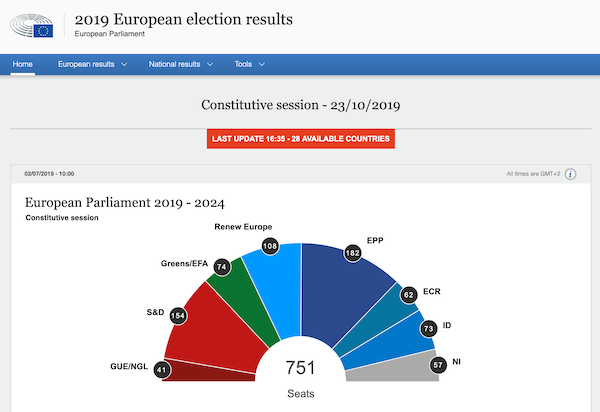
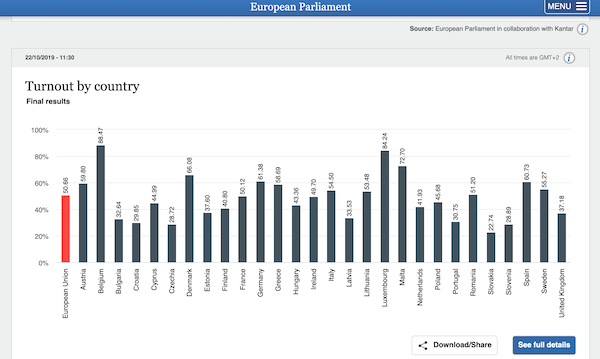
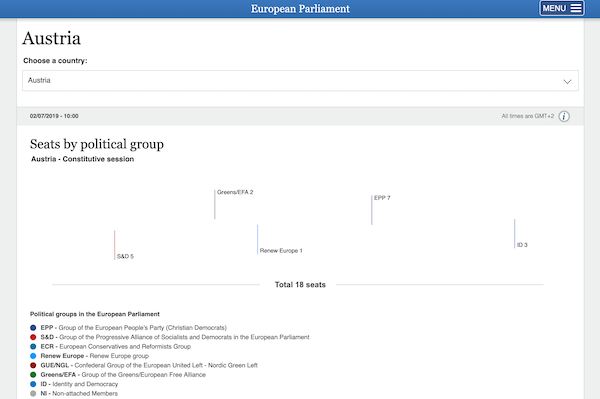

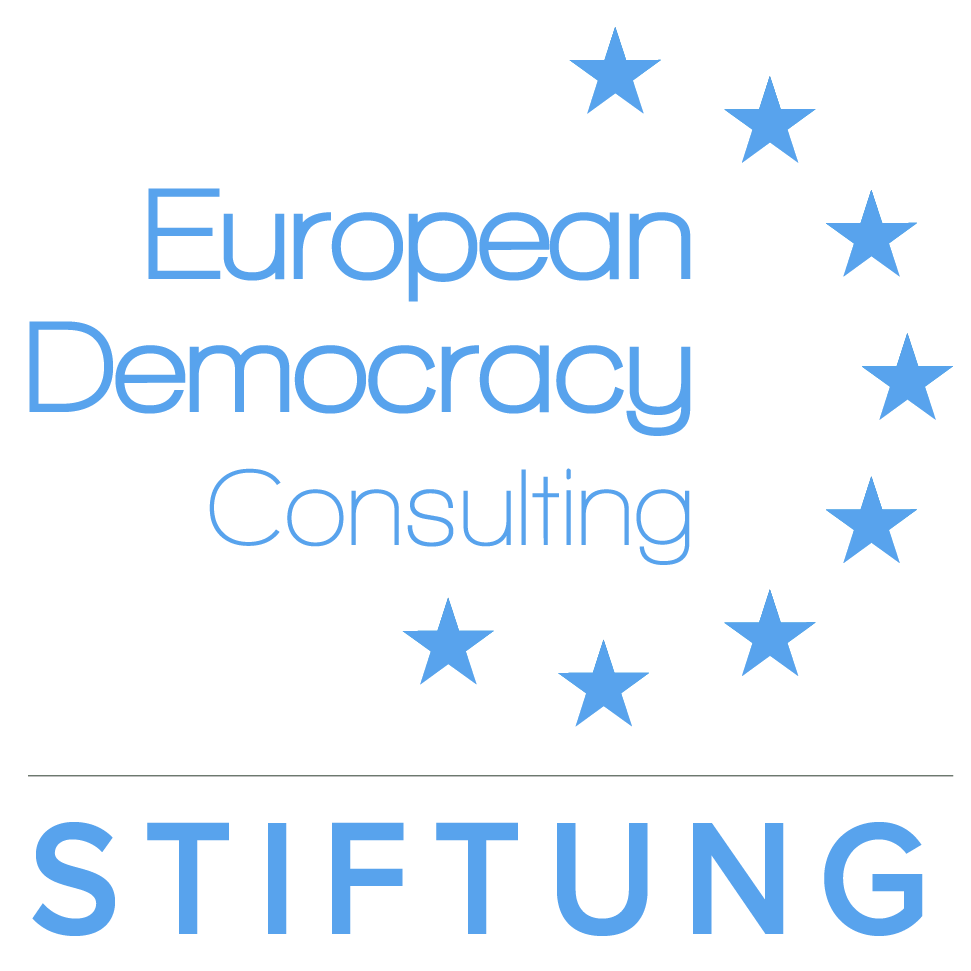
Pingback: Visualising donations and contributions – European Democracy Consulting